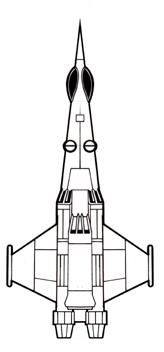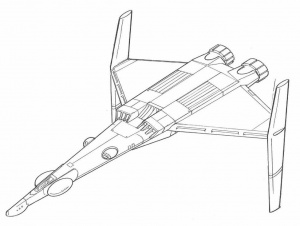Lurushaar Kilaalum class Corvette
| Lurushaar Kilaalum class Corvette | |
|---|---|
 TBD | |
| Type: HTP Patrol Corvette | |
| Category | ACS |
| Size | 400 Tons |
| Hull Configuration | Needle Hull |
| Streamlining | Airframe Hull |
| Tech Level | TL–13 |
| Engineering | |
| Computer | Model/3 |
| Jump | J-3 |
| Maneuver | 3 G |
| Armaments | |
| Hardpoints | 5 |
| Accommodations | |
| Staterooms | 0 |
| Personnel | |
| Crew | TBD |
| High/Mid Passengers | 0 |
| Payload | |
| Cargo | TBD Tons |
| Fuel tank | 0 Tons |
| Construction | |
| Origin | Third Imperium |
| Price | |
| Cost | MCrTBD |
| Statistics | |
| Quick Ship Profile | E-EA53 |
| Images | |
| Blueprint | Yes |
| Illustration | Yes |
| Source | |
| Also see | Type T class Patrol Ship |
| Canon | Published, fan design |
| Era | 1105 |
| Reference | Starship Operator's Manual 58. |
| Starships are designed with the Classic Traveller format, using High Guard. | |
The Lurushaar Kilaalum class Corvette is a light warship.
- It is sometimes notated as a Lurushaar Kilaalum class Patrol Cruiser.
- Its QSP is Corvette (E-EA53).
- It is a military ship and a Corvette.
Description (Specifications)
Description: Built on a 400-ton TL-13 winged airframe, it mounts drives capable of Jump-3 and 3-G acceleration, with fuel tankage to support both jump and three months of operations. It has fuel scoops to for gas giant skimming. Adjacent to the bridge is a Model/3 computer and an extensive sensor suite. There are five hardpoints filled with an array of powerful weapons.[1]
Crew Dossier: The corvette requires a number of crew. [2]
Image Repository
- A Type T or Lurushaar Kilaalum in 3D B&W render.

Basic Ship Characteristics
Following the Imperial Navy and IISS Universal Ship Profile and data, additional information is presented in the format shown here. The small craft factor indicates the number of squadrons (of ten craft) carried on the ship. Tonnage on the universal ship profile is shown in kilotons (thousands of tons) where necessary. [3]
| Basic Ship Characteristics [4] | ||
|---|---|---|
| No. | Category | Remarks |
| 1. | Tonnage | 400 tons. |
| 2. | Crew | xTBD crew. |
| 3. | Performance | Propulsion:
|
| 4. | Electronics | Model/3 computer. |
| 5. | Hardpoints | x4 hardpoints. |
| 6. | Armament | The normal weapons fit-out for it is:
|
| 7. | Defenses | No information yet available. |
| 8. | Craft | TBD |
| 9. | Fuel Treatment | TBD |
| 10. | Cost | MCrTBD. |
| 11. | Construction Time | TBD months to build, TBD months in quantity. |
| 12. | Comments | TBD
|
History & Background (Dossier)
Remarks: The Corvette is the Navy’s equivalent of the Scout/Courier, only bigger, faster, and better armed. [5]
After the Solomani Rim War, the Imperium faced two big problems - clearing Solomani holdout forces from the area, and also dealing with the use of older Imperial designs by some of those forces.[6]
Planetary holdouts would be dealt with by traditional occupation methods: interdiction of supplies, isolation from the planetary population, and strikes on detected bases.[7]
Other holdouts, especially in the outer system, were more pressing - none more so than raiders hiding around asteroid belts and in and around gas giants.[8]
Because of the essential nature of frontier refueling, especially in the light of the damage to ports and shipping during the war - securing gas giants was a vital necessity.[9]
Patrol assets were needed for the task - but there was one problem: current vessels were not suited for patrolling gas giant atmospheres for any useful length of time, and these vessels were also in widespread use in the coreward section of the former Solomani Sphere - and so could be used to make sneak attacks on shipping.[10]
The Lurishar Killaum Patrol Cruiser had been developed at the behest of a particularly insightful staff officer during the middle of the conflict, and so was available to undertake stabilization duties during the post-bellum era.[11]
Its airframes hull was suited to crushing in the upper and middle atmosphere of typical gas giants in low-emissions modes. The balanced laser/missile armament allowed gas giant specific munitions to be utilized. Finally, the addition of a long-endurance military boat added not only a great utility craft - but a very useful spotter for coordinating attacks in and around gas giant.[12]
Coupled with the fast withdrawal of earlier classes of patrol vessels, the new patrol cruiser enabled a rapid return to normalcy for the rimward area of the Third Imperium.[13]
Class Naming Practice/s & Peculiarities
In honor of the Vilani officer who first proposed the class, most of these vessels use Vilani-themed names. [14]
Selected Variant Types & Classes
References & Contributors (Sources)
| This article has metadata. |
| This article is missing content for one or more detailed sections. Additional details are required to complete the article. You can help the Traveller Wiki by expanding it. |
- Dave Sering. Starships and Spacecraft (Judges Guild, 1979), TBD.
- Rob Caswell, William W. Connors, Joe Fugate, Gary L. Thomas. Starship Operator's Manual (Digest Group Publications, 1988), 58.
- Marc Miller. T5 Core Rules (Far Future Enterprises, 2013), TBD.
- Marc Miller. Starships and Spacecraft (Far Future Enterprises, 2014), TBD.
- Traveller Wiki Editorial Team
- Author & Contributor: EW
- Author & Contributor: Lord (Marquis) and Master of Sophontology Maksim-Smelchak of the Ministry of Science
- ↑ Marc Miller. "Starship Design and Construction." T5 Core Rules (2013): 358.
- ↑ Information provided to the library by Maksim-Smelchak
- ↑ Timothy B. Brown. Fighting Ships (Game Designers Workshop, 1981), 10.
- ↑ Timothy B. Brown. Fighting Ships (Game Designers Workshop, 1981), 10.
- ↑ Marc Miller. "Starship Design and Construction." T5 Core Rules (2013): 358.
- ↑ Information provided to the library by EW
- ↑ Information provided to the library by EW
- ↑ Information provided to the library by EW
- ↑ Information provided to the library by EW
- ↑ Information provided to the library by EW
- ↑ Information provided to the library by EW
- ↑ Information provided to the library by EW
- ↑ Information provided to the library by EW
- ↑ Information provided to the library by Maksim-Smelchak